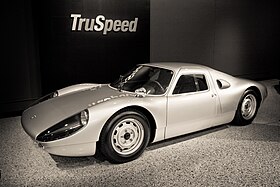Porsche 904
| Porsche 904 | |
|---|---|
 |
The Porsche 904 is an automobile which was produced by Porsche in Germany in 1964 and 1965. It was officially called Porsche Carrera GTS due to the same naming rights problem that required renaming the Porsche 901 to Porsche 911.
After having withdrawn from Formula One at the end of the 1962 season, Porsche focused again on sportscar racing. The 904 debuted late in 1963, for the 1964 racing season, as a successor to the 718, which had been introduced in 1957. Porsche designed the GTS variant to compete in the FIA-GT class at various international racing events. The street-legal version debuted in 1964 in order to comply with group 3 appendix J homologation regulations requiring a certain number of road-going variants be sold by the factory. Porsche produced one-hundred six 904s at four or five a day with a list price of US$7245 (FOB Stuttgart). Orders far exceeded the one hundred car requirement to satisfy homologation rules and more cars could have been sold. The 904 marked the beginning of a series of sportscars that culminated in the dominant 917.
The 904's mid-engine layout was inherited from the 718, also known as the RSK (Rennsport = racing, kurz = short), the factory's leading race car. It was powered by the 1,966 cc (120 cu in) Type 587/3, four-cam flat four-cylinder engine producing 198 hp (148 kW), "probably the most complex four-cylinder" ever. It drove a five-speed transmission with a standard 4.428:1 final drive, with available 4.605, 4.260, 3.636, and 3.362 ratios.
Begun as the Type 547, its development began in 1953, when the previous VW-based 1,100 cc (67 cu in) flat-four, used in the contemporary 356 and rated at 38 hp (28 kW), hit the limit of its potential. Porsche realized it needed something all-new. The brainchild of Ernst Fuhrmann, later technical director, it was hoped to achieve an "unheard of" 70 hp (52 kW) per 1 l (61 cu in), relying on hemispherical combustion chambers (which would be called hemis in the U.S.) and 46 mm (1.8 in)-throat 46IDA2 two-chokeWeber carburetors to generate 112 hp (84 kW) from the 1,500 cc (92 cu in) four-cam engine. The 1.5 liter weighed 310 lb (140 kg) dry, eventually producing 180 hp (134 kW). A complex design that proved "very taxing" to build and assemble, but very durable, it was used in 34 different models, including 550 spyders, 356 Carreras, and F2/1s.
...
Wikipedia
